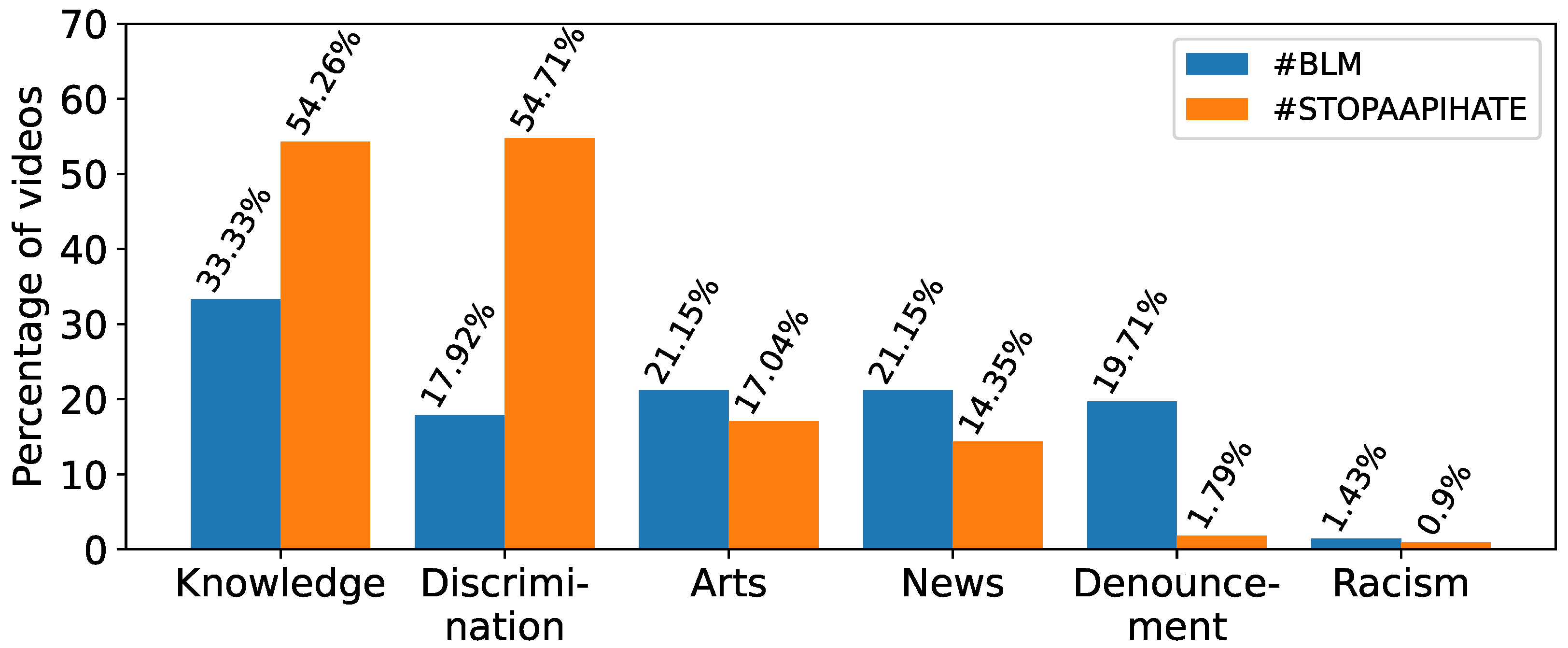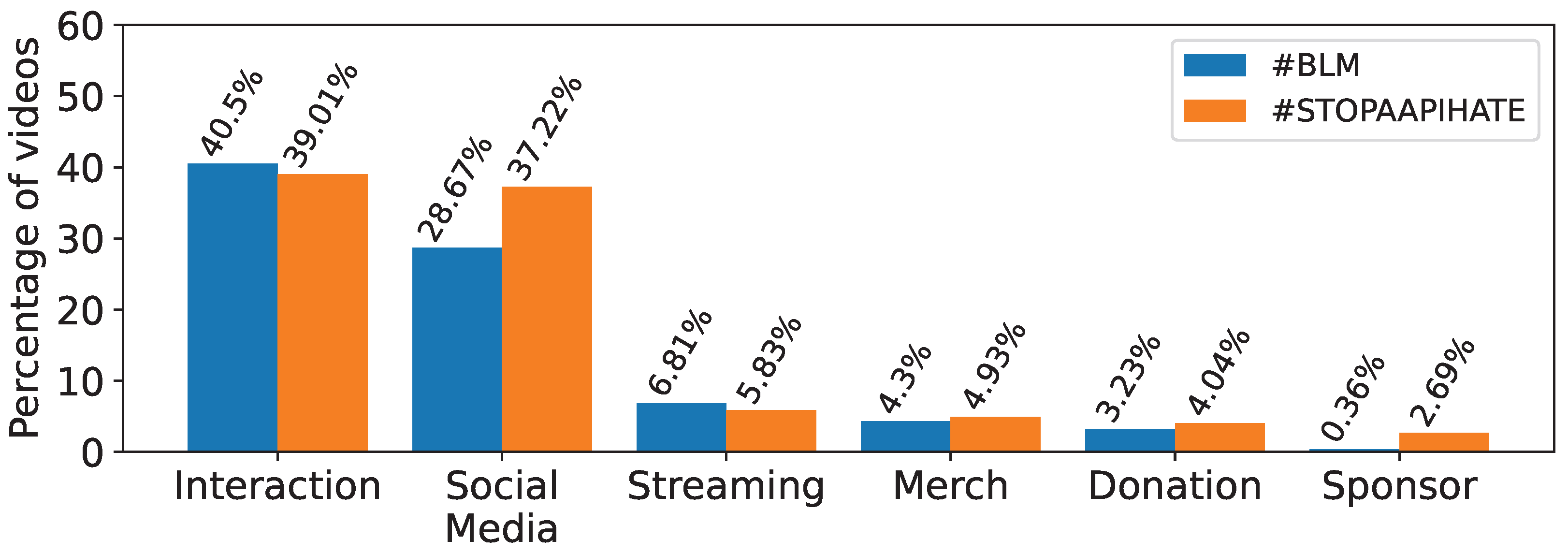Voices in Videos: How YouTube Is Used in #BLM and #StopAAPIHate Movements
Abstract
1. Introduction
- RQ1
- Who are the speakers or presenters featured in YouTube #BLM and #StopAAPIHate videos?
- RQ2
- What information is conveyed in YouTube #BLM and #StopAAPIHate videos, and what storytelling techniques are employed?
- RQ3
- Which video-sharing features do content creators commonly utilize to engage and interact with viewers?
2. Related Work
2.1. Social Movements and Social Media
2.2. YouTube Culture and Social Movements
2.3. Understanding Social Movements on YouTube
3. Data Collection and Analysis Method
4. Results
4.1. RQ1: Video Figure Types
4.2. RQ2: Video Information
4.2.1. Information
4.2.2. Storytelling
4.3. RQ3: Audience Interaction
5. Discussion
5.1. Public Figures and Vloggers in YouTube Movement Participation
5.2. Informal Information and Conversation About Racial Movements
5.3. Lack of Use of Video-Sharing Platform Features
6. Conclusions
Author Contributions
Funding
Institutional Review Board Statement
Informed Consent Statement
Data Availability Statement
Conflicts of Interest
Abbreviations
| BLM | Black Lives Matter |
| AAPIs | Asian Americans and Pacific Islanders |
References
- Mundt, M.; Ross, K.; Burnett, C.M. Scaling Social Movements Through Social Media: The Case of Black Lives Matter. Soc. Media Soc. 2018, 4, 2056305118807911. [Google Scholar] [CrossRef]
- Meek, D. YouTube and Social Movements: A Phenomenological Analysis of Participation, Events and Cyberplace. Antipode 2012, 44, 1429–1448. [Google Scholar] [CrossRef]
- Kellner, D.; Kim, G. YouTube, Critical Pedagogy, and Media Activism. Rev. Educ. Pedagog. Cult. Stud. 2010, 32, 3–36. [Google Scholar] [CrossRef]
- Poell, T.; van Dijck, J. Social media and new protest movements. In The SAGE Handbook of Social Media; Burgess, J., Marwick, A., Poell, T., Eds.; SAGE Publications Ltd: London, UK, 2018; pp. 546–561. [Google Scholar] [CrossRef]
- Askanius, T.; Uldam, J. Online social media for radical politics: Climate change activism on YouTube. Int. J. Electron. Gov. 2011, 4, 69–84. [Google Scholar] [CrossRef]
- Wilson, E.J.; Sherrell, D.L. Source effects in communication and persuasion research: A meta-analysis of effect size. J. Acad. Mark. Sci. 1993, 21, 101–112. [Google Scholar] [CrossRef]
- Berger, S.; Niebuhr, O.; Zellers, M. A Preliminary Study of Charismatic Speech on YouTube: Correlating Prosodic Variation with Counts of Subscribers, Views and Likes. In Proceedings of the Interspeech 2019, Graz, Austria, 15–19 September 2019; pp. 1761–1765. [Google Scholar] [CrossRef]
- Cunningham, S.; Craig, D. Being ‘really real’ on YouTube: Authenticity, community and brand culture in social media entertainment. Media Int. Aust. 2017, 164, 71–81. [Google Scholar] [CrossRef]
- Kitts, J. Mobilizing in black boxes: Social networks and participation in social movement organizations. Mobilization Int. Q. 2000, 5, 241–257. [Google Scholar] [CrossRef]
- Thorson, K.; Driscoll, K.; Ekdale, B.; Edgerly, S.; Thompson, L.G.; Schrock, A.; Swartz, L.; Vraga, E.K.; Wells, C. Youtube, twitter and the occupy movement. Inf. Commun. Soc. 2013, 16, 421–451. [Google Scholar] [CrossRef]
- Kidd, D.; McIntosh, K. Social media and social movements. Sociol. Compass 2016, 10, 785–794. [Google Scholar] [CrossRef]
- Stewart, L.G.; Arif, A.; Nied, A.C.; Spiro, E.S.; Starbird, K. Drawing the Lines of Contention: Networked Frame Contests Within #BlackLivesMatter Discourse. Proc. ACM Hum.-Comput. Interact. 2017, 1, 96. [Google Scholar] [CrossRef]
- Lee, C.S.; Jang, A. Questing for Justice on Twitter: Topic Modeling of #StopAsianHate Discourses in the Wake of Atlanta Shooting. Crime Delinq. 2023, 69, 2874–2900. [Google Scholar] [CrossRef]
- Cao, J.; Lee, C.; Sun, W.; De Gagne, J.C. The #StopAsianHate Movement on Twitter: A Qualitative Descriptive Study. Int. J. Environ. Res. Public Health 2022, 19, 3757. [Google Scholar] [CrossRef] [PubMed]
- Kim, S.; Lee, A. Black Lives Matter and Its Counter-Movements on Facebook (December 7, 2021). Available online: https://ssrn.com/abstract=3980259 (accessed on 31 December 2024).
- Tong, X.; Li, Y.; Li, J.; Bei, R.; Zhang, L. What are People Talking about in #BackLivesMatter and #StopAsianHate? Exploring and Categorizing Twitter Topics Emerged in Online Social Movements through the Latent Dirichlet Allocation Model. In Proceedings of the 2022 AAAI/ACM Conference on AI, Ethics, and Society, AIES ’22, New York, NY, USA, 19–21 May 2021; pp. 723–738. [Google Scholar] [CrossRef]
- Guo, J.; Liu, S. From #BlackLivesMatter to #StopAsianHate: Examining Network Agenda-Setting Effects of Hashtag Activism on Twitter. Soc. Media Soc. 2022, 8, 20563051221146182. [Google Scholar] [CrossRef]
- Hawkins, D.S. “When you Search a #Hashtag, it Feels Like You’re Searching for Death”: Black Twitter and Communication About Police Brutality Within the Black Community. Soc. Media Soc. 2023, 9, 20563051231179705. [Google Scholar] [CrossRef]
- Park, S.Y.; Santero, N.K.; Kaneshiro, B.; Lee, J.H. Armed in ARMY: A Case Study of How BTS Fans Successfully Collaborated to #MatchAMillion for Black Lives Matter. In Proceedings of the 2021 CHI Conference on Human Factors in Computing Syste, CHI ’21, New York, NY, USA, 8–13 May 2021. [Google Scholar] [CrossRef]
- Lopes, A.R. The impact of social media on social movements: The new opportunity and mobilizing structure. J. Political Sci. Res. 2014, 4, 1–23. [Google Scholar]
- Arthurs, J.; Drakopoulou, S.; Gandini, A. Researching YouTube. Convergence 2018, 24, 3–15. [Google Scholar] [CrossRef]
- Niu, S.; Mai, C.; McKim, K.G.; McCrickard, D.S. #TeamTrees: Investigating How YouTubers Participate in a Social Media Campaign. Proc. ACM Hum.-Comput. Interact. 2021, 5, 449. [Google Scholar] [CrossRef]
- Khamis, S.; Ang, L.; Welling, R. Self-branding, ‘micro-celebrity’ and the rise of Social Media Influencers. Celebr. Stud. 2017, 8, 191–208. [Google Scholar] [CrossRef]
- Lewis, R. “This Is What the News Won’t Show You”: YouTube Creators and the Reactionary Politics of Micro-celebrity. Telev. New Media 2019, 21, 201–217. [Google Scholar] [CrossRef]
- Knupfer, H.; Neureiter, A.; Matthes, J. From social media diet to public riot? Engagement with ‘greenfluencers’ and young social media users’ environmental activism. Comput. Hum. Behav. 2023, 139, 107527. [Google Scholar] [CrossRef]
- Lim, J.S.; Golan, G.J. Social Media Activism in Response to the Influence of Political Parody Videos on YouTube. Commun. Res. 2011, 38, 710–727. [Google Scholar] [CrossRef]
- Sofia Triliva, C.V.; Dafermos, M. YouTube, young people, and the socioeconomic crises in Greece. Inf. Commun. Soc. 2015, 18, 407–423. [Google Scholar] [CrossRef]
- Dibble, J.L.; Hartmann, T.; Rosaen, S.F. Parasocial Interaction and Parasocial Relationship: Conceptual Clarification and a Critical Assessment of Measures. Hum. Commun. Res. 2016, 42, 21–44. [Google Scholar] [CrossRef]
- Giles, D.C. Parasocial Interaction: A Review of the Literature and a Model for Future Research. Media Psychol. 2002, 4, 279–305. [Google Scholar] [CrossRef]
- Moyer-Gusé, E. Toward a Theory of Entertainment Persuasion: Explaining the Persuasive Effects of Entertainment-Education Messages. Commun. Theory 2008, 18, 407–425. [Google Scholar] [CrossRef]
- Su, B.C.; Wu, L.W.; Chang, Y.Y.C.; Hong, R.H. Influencers on Social Media as References: Understanding the Importance of Parasocial Relationships. Sustainability 2021, 13, 10919. [Google Scholar] [CrossRef]
- Tukachinsky, R.; Walter, N.; Saucier, C.J. Antecedents and Effects of Parasocial Relationships: A Meta-Analysis. J. Commun. 2020, 70, 868–894. [Google Scholar] [CrossRef]
- Jenkins, J.C. Resource mobilization theory and the study of social movements. Annu. Rev. Sociol. 1983, 9, 527–553. [Google Scholar] [CrossRef]
- Eltantawy, N.; Wiest, J.B. The Arab spring| Social media in the Egyptian revolution: Reconsidering resource mobilization theory. Int. J. Commun. 2011, 5, 18. [Google Scholar]
- Gray-Hawkins, M. Collective movements, digital activism, and protest events: The effectiveness of social media concerning the organization of large-scale political participation. Geopolit. Hist. Int. Relat. 2018, 10, 64–69. [Google Scholar]
- Kavada, A. Engagement, bonding, and identity across multiple platforms: Avaaz on Facebook, YouTube, and MySpace. MedieKultur J. Media Commun. Res. 2012, 28, 28–48. [Google Scholar] [CrossRef]
- Wattenhofer, M.; Wattenhofer, R.; Zhu, Z. The YouTube social network. In Proceedings of the International AAAI Conference on Web and Social Media, Dublin, Ireland, 4–7 June 2012; Volume 6, pp. 354–361. [Google Scholar]
- Sumiala, J.M.; Tikka, M. Broadcast Yourself—Global News! A Netnography of the “Flotilla” News on YouTube*. Commun. Cult. Crit. 2013, 6, 318–335. [Google Scholar] [CrossRef]
- Vraga, E.K.; Bode, L.; Wells, C.; Driscoll, K.; Thorson, K. The Rules of Engagement: Comparing Two Social Protest Movements on YouTube. Cyberpsychol. Behav. Soc. Netw. 2013, 17, 133–140. [Google Scholar] [CrossRef] [PubMed]
- Osman, N.S.; Kim, J.H.; Park, J.H.; Park, H.W. Identifying the Impacts of Social Movement Mobilization on YouTube: Social Network Analysis. Information 2025, 16, 55. [Google Scholar] [CrossRef]
- Antony, M.G.; Thomas, R.J. ‘This is citizen journalism at its finest’: YouTube and the public sphere in the Oscar Grant shooting incident. New Media Soc. 2010, 12, 1280–1296. [Google Scholar] [CrossRef]
- Jacobs, R.N. Race, Media, and the Crisis of Civil Society: From Watts to Rodney King; Cambridge University Press: Cambridge, UK, 2000. [Google Scholar]
- Braun, V.; Clarke, V. Thematic Analysis. In Encyclopedia of Critical Psychology; Springer: Berlin/Heidelberg, Germany, 2012. [Google Scholar] [CrossRef]
- Che, X.; Ip, B.; Lin, L. A Survey of Current YouTube Video Characteristics. IEEE Multimed. 2015, 22, 56–63. [Google Scholar] [CrossRef]
- Lebron, C.J. The Making of Black Lives Matter: A Brief History of an Idea; Oxford University Press: Oxford, UK, 2023. [Google Scholar]
- Walker, R.L.; Kaye, L.K. Using Twitter Data to Explore Public Discourse to Antiracism Movements. Technol. Mind Behav. 2022, 3, 1–20. Available online: https://tmb.apaopen.org/pub/6nbhufpr (accessed on 31 December 2024). [CrossRef]
- Khan, M.L. Social media engagement: What motivates user participation and consumption on YouTube? Comput. Hum. Behav. 2017, 66, 236–247. [Google Scholar] [CrossRef]
- Pires, K.; Simon, G. YouTube live and Twitch: A tour of user-generated live streaming systems. In Proceedings of the 6th ACM Multimedia Systems Conference, MMSys ’15, New York, NY, USA, 18–20 March 2015; pp. 225–230. [Google Scholar] [CrossRef]




| Category | Definition | |
|---|---|---|
| Identity | Artist | People who display artistic content such as painting, drawing, music, and comedy |
| Public figure | Celebrities, professionals, and public figures who hold official roles | |
| Ordinary people | Regular individuals who participate in the movement | |
| Religious figure | Pastors or people who appear in religious places like churches | |
| Reporter | Traditional news reporters | |
| Vlogger | Vloggers are content creators who produce commentary or everyday-life videos on their YouTube channels. | |
| Information | Arts | Music, painting, crafting, or other forms of art |
| Denouncement | Highlighting issues or problems with the movement | |
| Discrimination | Stories or personal experiences of discrimination | |
| Knowledge | Information or insights about the movements | |
| News | Traditional news reports | |
| Storytelling | Conversational | Talking to viewers directly in front of the camera |
| Informational | Infographics | |
| Artistic | Demonstrating artistic skills or showing the creative process | |
| Promotional | Short videos that feature slogans or advertisements | |
| Interaction | Donation | Using YouTube’s donation features |
| Interaction | Encouraging viewers to like, subscribe, or comment on the video | |
| Merch | Selling products | |
| Social Media | Displaying social media handles in the video | |
| Sponsor | Promoting a product or advertising for a sponsor |
Disclaimer/Publisher’s Note: The statements, opinions and data contained in all publications are solely those of the individual author(s) and contributor(s) and not of MDPI and/or the editor(s). MDPI and/or the editor(s) disclaim responsibility for any injury to people or property resulting from any ideas, methods, instructions or products referred to in the content. |
© 2025 by the authors. Licensee MDPI, Basel, Switzerland. This article is an open access article distributed under the terms and conditions of the Creative Commons Attribution (CC BY) license (https://creativecommons.org/licenses/by/4.0/).
Share and Cite
Bali, A.; Niu, S. Voices in Videos: How YouTube Is Used in #BLM and #StopAAPIHate Movements. Platforms 2025, 3, 8. https://doi.org/10.3390/platforms3020008
Bali A, Niu S. Voices in Videos: How YouTube Is Used in #BLM and #StopAAPIHate Movements. Platforms. 2025; 3(2):8. https://doi.org/10.3390/platforms3020008
Chicago/Turabian StyleBali, Aanandita, and Shuo Niu. 2025. "Voices in Videos: How YouTube Is Used in #BLM and #StopAAPIHate Movements" Platforms 3, no. 2: 8. https://doi.org/10.3390/platforms3020008
APA StyleBali, A., & Niu, S. (2025). Voices in Videos: How YouTube Is Used in #BLM and #StopAAPIHate Movements. Platforms, 3(2), 8. https://doi.org/10.3390/platforms3020008






